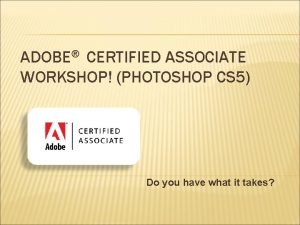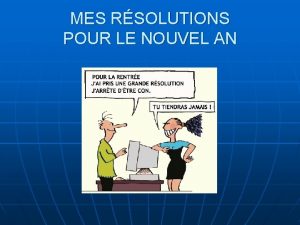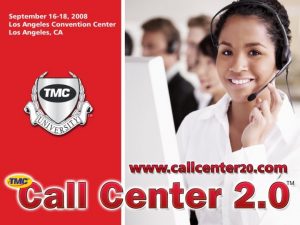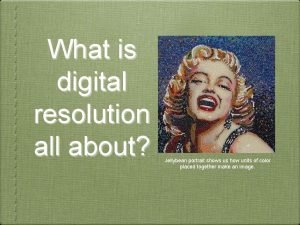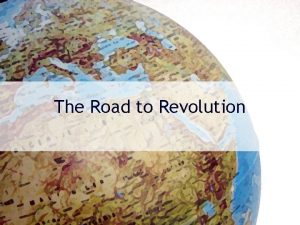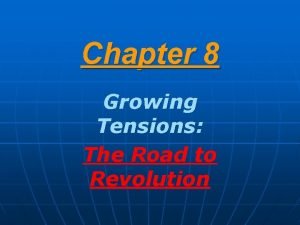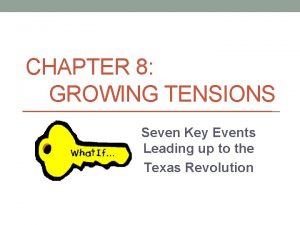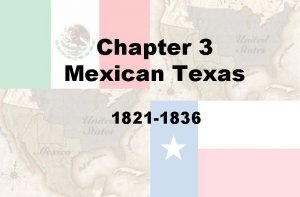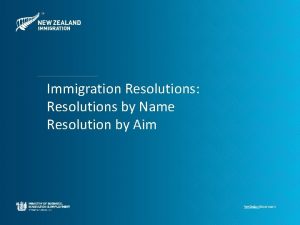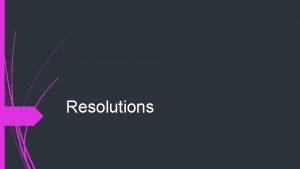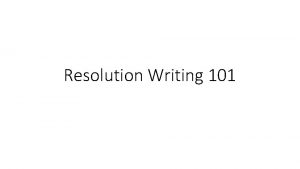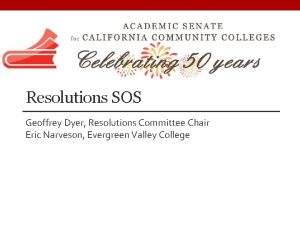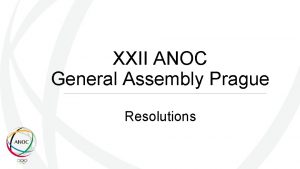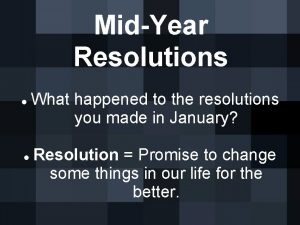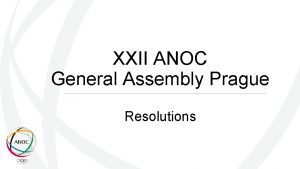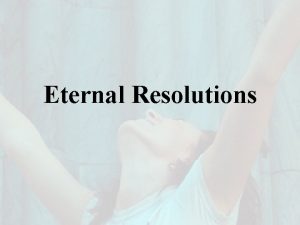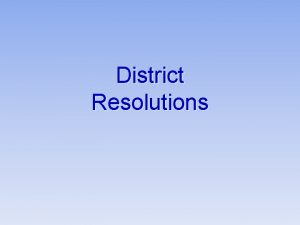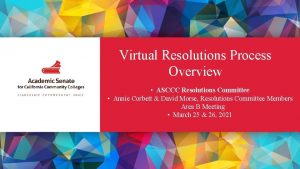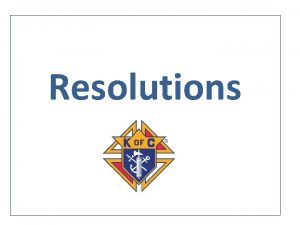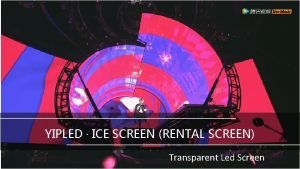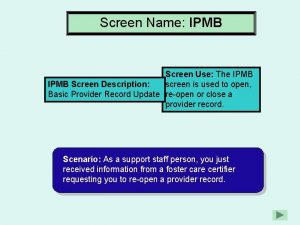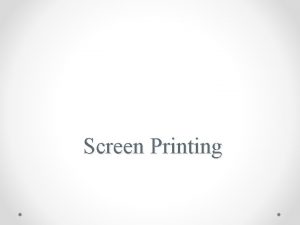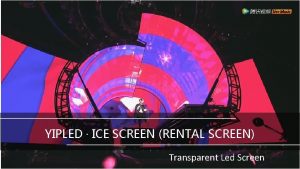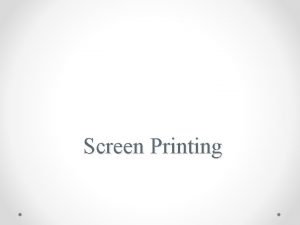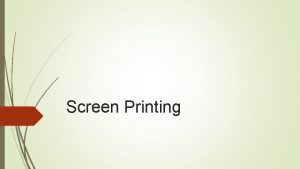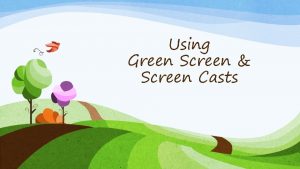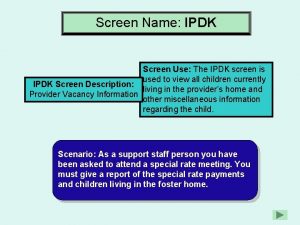Designing for Multiple Screen Resolutions Screen resolution is


























- Slides: 26


Designing for Multiple Screen Resolutions • Screen resolution is the width and height of the computer screen in pixels • Most monitors have many screen resolutions to choose from • This is a variable you cannot control • The current most common resolutions are 1024 x 768 and 1280 x 1024 • Wide-screen resolutions such as 1366 x 768 and 1200 x 800 are popular as well 2

Flexible Page Layouts • • Adapt to different screen resolutions Work especially well for text-based content Can pose a variety of design challenges The design must account for the movement of elements on the screen at different resolutions • At high resolutions, your content can break apart 3

Fixed-Width Page Layouts • Allows Web pages to be designed like print pages • Have consistent width and height • Designed to center in the browser window regardless of screen resolution • Easier to design than flexible layouts 4

Suggestions for Solving the Screen Resolution Dilemma • Flexible designs: – User controls the view of the content – Less chance of horizontal scrolling – More flexibility for multiple devices – Better suited to text-based layouts and simpler designs • Fixed-width designs: – Designer controls the view of the content – Allow more complex page layouts – More control over text length 5

Balance Design and Content • Access to your content and user needs should guide your design • Many sites have unnecessary design elements • These factors can distract the user • A Web site’s design should complement the content and support the reader • Always choose simple and direct designs that showcase content and allow easy access 6

Plan for Easy Access to Your Information • Information design is the most important factor in the success of your site • Determines how users access content • Organize your content • Presented as a navigable set of information • Provide navigation choices to the user • Users may browse or look for specific information • Anticipate and plan for user actions • Provide direct links to your most popular pages 7

Plan for Easy Presentation of Your Information • Design information to be easy to read and legible • Break text into reasonable segments • Provide contrasting colors that are easy on the eye • Use plenty of white space • Readers have different online reading habits • Include plenty of headings • Control the width of your text 8

Plan Smooth Transitions • Plan to create a unified look • Reinforce identifying elements • Consistency and repetition create smooth transitions • Place navigation elements in the same position on each page • Use the same navigation graphics throughout the site 9

Creating a Unified Site Design • Plan the unifying themes and structure for your site • Communicate a visual theme with your design choices • Consider more than each page • Plan smooth transitions • Use a grid to provide visual structure • Include active white space 10

Plan Smooth Transitions • Plan to create a unified look • Reinforce identifying elements • Consistency and repetition create smooth transitions • Place navigation elements in the same position on each page • Use the same navigation graphics throughout the site 11

Use Active White Space • • White spaces are the blank areas of the page Use white space deliberately Good use of white space guides the reader White space that is used deliberately is called active white space • Passive white space is the result of mismatched shapes • Plenty of active white space reduces clutter and clarifies organization 12

Designing for the User • Keep your design efforts centered solely on your user • Find out what users expect from your site • If you can, survey them with an online form • Create a profile of your average user • What do users want when they get to your site? 13

Design for Interaction • Think about how the user wants to interact with your information • Design for your content type • Decide whether the user is likely to read or scan • Design pages for reading or scanning based on the content type 14

How Much Content Is Too Much? • • • Don’t overcrowd your pages with information Be conscious of the cognitive load of the user Carefully divide content into smaller sections Present content in a structured manner Provide plenty of navigation cues Reformat Content for Online Presentation • Cannot post print documents directly online • Text length, font, and content length do not transfer well • Re-design paper content for online display 15

Creating a Site Specification • Who is the client for the site? • Can you write a two- or three-paragraph mission statement that briefly states the site’s goals? • What do you envision as the goal of the site? • What do you (or your company or organization) hope to gain from creating and maintaining a Web site? • What are the requirements for the Web site? 16

Creating a Site Specification • • • Are the requirements feasible? How will you judge the success of the site? Who is the target audience? What are the limiting technical factors? What is the budget? Is this a new site or an upgrade? 17

Identifying the Content Goal • Examine closely what type of site you are building • Your objectives and your users’ objectives may be quite different • Adopt your users’ perspective • Think about the type of content you’re presenting and look to the Web for examples of how best to present it 18

Identifying the Content Goal • Types of Web sites: – – – Billboard Publishing Portal Special interest Blog – Social networking – – Wikis RSS Virtual gallery E-commerce, catalog, online shopping – Product support – Intranet/Extranet 19

Creating a Site Storyboard • • Plan your site by creating a storyboard flowchart The flowchart shows structure logic and taxonomy This is an important planning step You can visualize and refine your site design Organizing Information Structure • Think about your users’ information needs • How should your information design map look? • Review the following sample structures and adapt them to information needs 20

Linear Structure Linear information structure 21

Tutorial Structure Tutorial structure 22

Web Structure Web structure 23

Hierarchical Structure Hierarchical structure 24

Cluster Structure Cluster structure 25

Catalog Structure Catalog structure 26
 Photoshop minimum requirements
Photoshop minimum requirements Mes resolutions pour le nouvel an
Mes resolutions pour le nouvel an First call resolution definition
First call resolution definition Portrait resolution sizes
Portrait resolution sizes Fredonian rebellion facts
Fredonian rebellion facts Federalists vs centralists mexico
Federalists vs centralists mexico Turtle bayou resolutions drawing
Turtle bayou resolutions drawing Turtle bayou resolutions
Turtle bayou resolutions High resolution low resolution
High resolution low resolution Screen small screen offscreen
Screen small screen offscreen Baseline
Baseline Multiple instruction single data
Multiple instruction single data Formuö
Formuö Stickprovsvariansen
Stickprovsvariansen Rutin för avvikelsehantering
Rutin för avvikelsehantering Läkarutlåtande för livränta
Läkarutlåtande för livränta Klassificeringsstruktur för kommunala verksamheter
Klassificeringsstruktur för kommunala verksamheter Myndigheten för delaktighet
Myndigheten för delaktighet Hur skriver man en tes
Hur skriver man en tes Tack för att ni lyssnade
Tack för att ni lyssnade En lathund för arbete med kontinuitetshantering
En lathund för arbete med kontinuitetshantering Tobinskatten för och nackdelar
Tobinskatten för och nackdelar Tack för att ni har lyssnat
Tack för att ni har lyssnat Var finns arvsanlagen
Var finns arvsanlagen Programskede byggprocessen
Programskede byggprocessen Fuktmätningar i betong enlig rbk
Fuktmätningar i betong enlig rbk Lufttryck formel
Lufttryck formel
